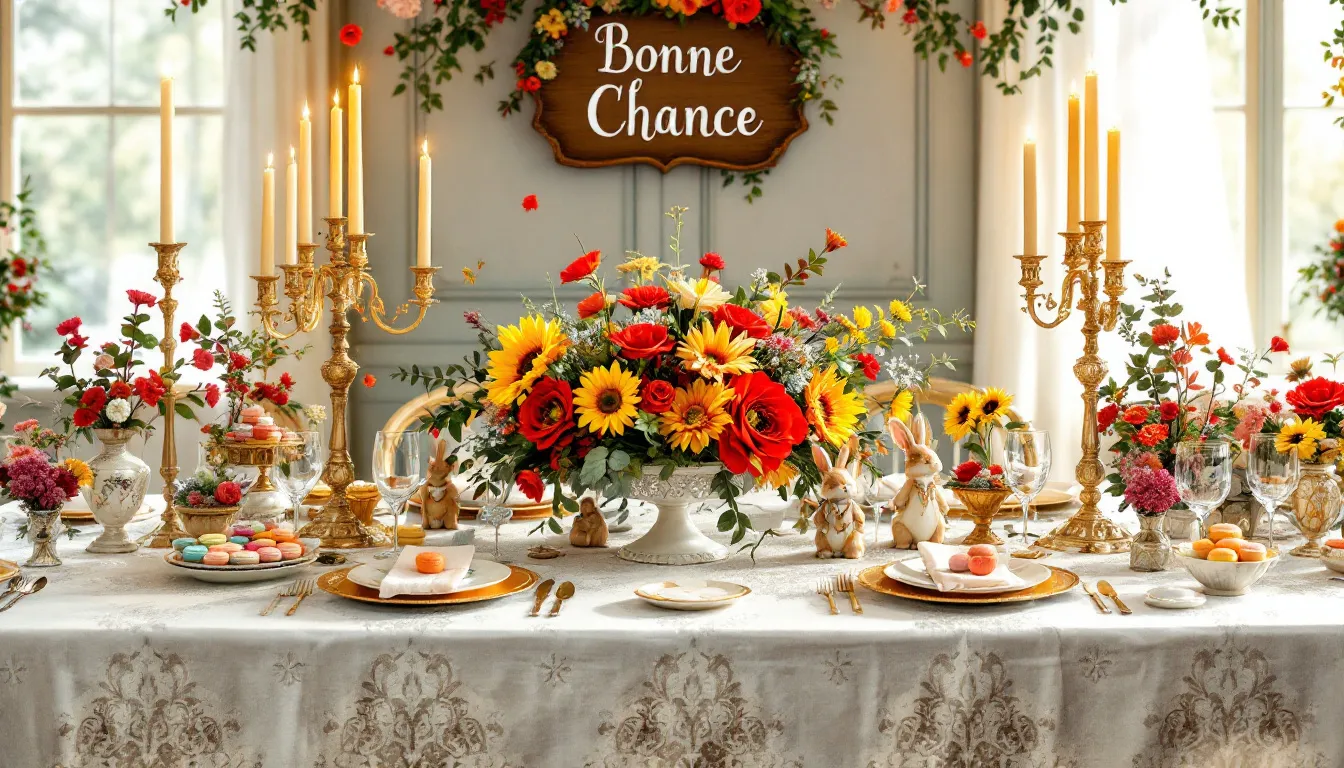Wedding Planning 101: Essential Tips for a Stress-Free Big Day
Welcome to Wedding Planning 101. This guide breaks down the wedding planning process into simple, actionable steps. From setting your budget to choosing a venue, we’ve got you covered. Let’s get started.
Key Takeaways
-
Establish a clear wedding budget early to avoid financial strain and manage unexpected costs.
-
Define your wedding vision to create a cohesive and personalized experience that reflects you as a couple.
-
Stay organized with a detailed to-do list and a finalized wedding day timeline to ensure a smooth event.
Start with a Wedding Budget
Before addressing the exciting details of your wedding day, establish a clear wedding budget. Understanding your overall financial situation will help you create a practical budget that won’t strain your finances. Open discussions about who will contribute financially can clarify expectations early in the wedding planning process. Including a buffer of 5-15% for unexpected costs and last-minute changes is also wise. This cushion can help manage potential stress when those inevitable little surprises occur.
Prioritize the elements that matter most to you and your partner. Whether it’s the perfect wedding venue, a stunning wedding cake, or top-notch wedding photography, knowing where to allocate your funds will make the planning more manageable. A well-planned budget sets the foundation for a successful wedding planning journey.
Define Your Wedding Vision
Once your budget is set, define your wedding vision. This helps align all planning elements to create a cohesive experience. Consider wedding styles like modern, classic, romantic, vintage, rustic, or glam. Choosing a concept such as specific colors, seasonal wedding inspiration, or a theme can guide your overall wedding design. Mood boards can be a fun way to identify the aesthetic and gather diverse wedding photo ideas.
Consider your personal interests and values. Do you and your partner love weddings with a casual or formal vibe? Perhaps you want to incorporate favorite activities or foods into your wedding day. Include sensory details such as sights, sounds, and feelings in your visualization.
Descriptive words can help communicate your vision to wedding vendors, ensuring they match your desired style. Ultimately, this step is about creating a day that reflects who you are as a couple.
Create a Detailed To-Do List
A comprehensive to-do list benefits every wedding planning journey. This master wedding planner checklist should include every task needed, from big decisions like booking a wedding venue to small details like packing an emergency kit.
Use apps, keep documents in a virtual space, or go old-school with a physical wedding notebook to stay organized. A well-thought-out wedding day schedule ensures smooth coordination for key stakeholders, keeping everything on track.
Choose Your Wedding Date and Venue
Choosing a wedding date and venue is a significant milestone in the planning process. Ideally, choose a date at least one year in advance to allow ample planning time. Consider the season, as it can set the mood for your wedding day. Check local calendars for major events that could conflict with your date and affect guest attendance. Also, consult your VIP guests’ availability to ensure they can join your celebration.
Booking your venue early is crucial, especially for popular sites that fill up quickly during peak seasons. Whether you prefer an outdoor ceremony or a cozy indoor setting, make sure the venue matches your wedding vision and can accommodate your guest count.
Weekday weddings are becoming more popular, offering better venue availability and lower costs. Once the date and venue are secured, you can proceed with other exciting planning details.
Build Your Guest List
Collaborate with your partner and key family members to create your guest list. The size of your wedding venue will dictate the guest list and influence vendor costs. Decide whether to include children, as this can affect your overall numbers.
Establish a consistent rule for plus-ones to ensure clarity for all guests invited. Once you’ve sent out save-the-dates, confirm your guest list to avoid errors and ensure everyone important is included.
Hire Key Wedding Vendors Early
Hire key wedding vendors early, as many popular vendors book more than a year in advance. Prioritize booking essential vendors like venues, florists, and caterers to secure your ideal choices. The wedding photographer should be one of the first vendors you hire due to their high demand.
Observing vendors’ communication style and reliability can help ensure they align with your expectations. Avoid vendors who show signs of unreliability or disinterest in your wedding vision.
Design and Send Save-the-Dates
Save-the-dates, typically sent out six to eight months before the wedding, are an essential part of the planning process. These cards inform guests of your wedding date and location early enough for them to make travel arrangements.
Elegant save-the-dates set the tone for your wedding day and build anticipation among your guests.
Take Engagement Photos
Engagement photos capture this special time in your lives. These photos help you become comfortable in front of the camera and can be used for social media announcements, save-the-dates, and even your wedding website.
An engagement session lets you experiment with different photo ideas and gather inspiration for your big day.
Create a Wedding Website
A wedding website is a practical and eco-friendly way to share essential information with your guests. Please provide details including dates and times. Also, include information about locations, dress codes, registries, transportation, lodging, and health and safety requirements.
Wedding websites can manage RSVPs in real-time and provide easy registry navigation. Personalize your website to reflect your love story and keep guests informed and excited.
Plan Your Wedding Ceremony
Your wedding ceremony begins with the processional, where the officiant and wedding party enter before the bride and groom. Couples can choose to use traditional vows or personalize their own promises, adding a meaningful touch to the ceremony.
A unity ceremony, like lighting a unity candle or performing a sand ceremony, symbolizes the couple’s union. The officiant’s pronouncement and the couple’s first kiss mark the official declaration of marriage and a pivotal moment in the ceremony.
Organize the Wedding Reception
Careful planning ensures a smooth and enjoyable wedding reception. Ideally, the reception lasts between 2-4 hours. Thoughtfully timed meal service often starts shortly after guests are welcomed. The grand entrance of the wedding party and couple typically occurs after guests have settled in, followed by the first dance to create a celebratory atmosphere.
Speeches usually occur after the first course during a multi-course meal to keep guests engaged. Parent dances add an emotional touch to the evening and are traditionally scheduled after the speeches.
The cake cutting ceremony signifies the transition towards more dancing and festivities. Ending the reception with a last dance and a well-planned exit, like a sparkler send-off, leaves a lasting impression.
Focus on Bridal Party Details
The bridal party supports the couple and ensures the wedding day runs smoothly. The maid or matron of honor supports the bride, handling planning decisions and coordinating communication within the bridal party. Groomsmen, led by the best man, support the groom and help with pre-wedding events and logistics on the wedding day.
Clear communication about costs and responsibilities manages expectations and reduces misunderstandings among bridal party members.
Shop for Wedding Attire
Shopping for wedding attire is an exciting part of planning. Brides typically start shopping for wedding dresses about 8.5 months before their wedding date and purchase their dress approximately 7.5 months prior. The average time for a wedding dress to be made ranges from four to six months, depending on the design. Personalize your wedding attire, including clothing, colors, and accessories, to add a unique touch to your special day.
Couples often secure their wedding dress undergarments and accessories about five to six months before the wedding. To ensure a seamless fitting experience, bring the undergarments and shoes you plan to wear to your alterations appointments.
Grooms and groomsmen should schedule attire shopping about five months before the wedding, considering whether to buy or rent and which suit style matches the wedding’s formality.
Choose Wedding Rings
Choosing wedding rings reflects the couple’s personal tastes and lifestyles. Select wedding bands that complement the engagement ring, as they are often worn together. Consider rings that can stack well with other jewelry pieces for a versatile style.
Choose durable materials if you have an active lifestyle or a profession requiring manual work. Regular maintenance and cleaning, including annual professional inspections, will keep your wedding rings in good condition.
Design Wedding Invitations
Designing wedding invitations sets the tone for your big day. Invitations serve as a preview of the wedding’s theme and style, influencing guest expectations. Choosing a legible font is crucial to ensure guests can easily read the invitation details. The color palette should reflect the emotions and atmosphere you intend for your wedding.
Selecting the right paper stock adds a unique touch and can enhance the overall appearance of your invitations. Mail local wedding invitations six to eight weeks in advance, while destination wedding invitations may need to be sent two to three months prior. Consistency in design across all wedding stationery ensures a cohesive look.
Plan Pre-Wedding Events
Pre-wedding events provide a wonderful way to celebrate your upcoming nuptials. Common events include engagement celebrations, showers, brunches, and bachelor/bachelorette parties. These provide opportunities for friends and family to meet and celebrate with you. Couples are responsible for creating guest lists for these events and giving them to the respective hosts.
Engagement parties, often hosted by close friends or family members, initiate the wedding celebrations. The rehearsal dinner, typically held on the eve of the wedding, can be tied into other events or remain a separate celebration. A welcome party for out-of-town guests is another thoughtful gesture.
Finalize the Wedding Day Timeline
A finalized wedding day timeline ensures a smooth and well-coordinated event. The timeline should encompass the entire day, from getting ready to the last dance. Schedule the ceremony, generally lasting between 30 minutes to an hour, to start about 15 minutes later than indicated on the invitation to account for late arrivals. If your ceremony and reception are at different locations, factor in travel time for guests. Including a first look can provide more flexibility for taking photos before the ceremony.
Most wedding receptions last from four to five hours, with a cocktail hour allowing guests to mingle while you take post-ceremony photos.
Speeches should be timed thoughtfully to keep the evening running smoothly. Double-check vendor arrival times and meal needs as the wedding day approaches, and inform vendors of timing information from the venue to coordinate setup.
Prepare for Unexpected Issues
Unexpected moments can arise on any wedding day, but preparation makes all the difference. Assemble a wedding emergency kit well in advance to address last-minute problems. Include a compact first aid kit with bandages and hand sanitizer, as well as snacks like protein bars to maintain energy.
A small sewing kit can be a lifesaver for quick repairs on wedding attire. Each item in your emergency kit ensures a smooth day, from handling injuries to wardrobe malfunctions.
Communicate with Your Vendors
Effective communication with your wedding vendors ensures a successful event. Regular communication and clarity of expectations are crucial. Finalize details with vendors, including contracts that specify date, location, fees, and services.
A detailed timeline helps vendors understand when to be present and whom to contact for questions. Organize vendor communication through preferred methods, such as email, to prevent miscommunication. Clear and consistent communication ensures everyone is on the same page, contributing to a seamless wedding day.
Consider Wedding Insurance
Wedding insurance provides peace of mind and protection against unforeseen events. Wedding insurance can cover costs associated with cancellations due to extreme weather events, ensuring financial protection for rescheduling. Liability insurance protects against financial responsibility for injuries or property damage occurring at the wedding venue.
Wedding items like engagement rings, wedding rings, and gifts can also be insured, providing coverage against theft or damage. Purchase wedding insurance soon after starting the planning process to cover nonrefundable deposits.
Personalize Your Wedding
Personalizing your wedding adds a meaningful touch to the celebration. Writing your own vows can make the ceremony feel more personal and heartfelt. Incorporate personal stories or inside jokes into your vows to enhance their emotional impact. Collaborate with your partner on the vows to ensure they are complementary and equally heartfelt.
DIY projects, like creating unique decorations, can reflect your personality as a couple. Utilizing family heirlooms or mementos in your wedding can add a sentimental touch, making your day even more special.
Plan the Rehearsal Dinner
The rehearsal dinner, typically held on the eve of the wedding, is a relaxed gathering for immediate family and the wedding party. It offers an opportunity to spend time with close family and friends and ensures everyone is prepared for the big day. The guest list usually includes immediate family, the wedding party, and potentially out-of-town guests.
The venue should ideally be within 20 miles of where guests are staying or the wedding location. Couples can opt for a formal or informal rehearsal dinner based on their preferences and budget. Send out invitations for the rehearsal dinner four to six weeks in advance.
Capture Special Moments
One of the most important aspects of your wedding day is capturing special moments. Engagement sessions offer a low-pressure environment for couples to practice being in front of the camera before the wedding. Discuss ideas with your photographer to ensure specific photo concepts are understood and included. The best time for family photos is just after the first look or the ceremony, maximizing lighting and availability. Allocate 20-30 minutes for family and group photographs to ensure everyone feels relaxed and comfortable.
Candid and personal moments are vital; discuss your desire for spontaneity in photos with your photographer. The best wedding photos often come from candid moments rather than overly staged poses.
Encourage your photographer to capture spontaneous moments among family to create a unique story. Incorporating personal elements and interactions into poses makes photos more meaningful. A well-planned photo list ensures all desired groupings are captured.
Enjoy the Process
Amidst all the planning, enjoy the process and prioritize your relationship. Have regular date nights with no wedding talk allowed to keep the romance alive. Taking time off before the wedding helps maintain sanity and reduce stress. Taking the week before the wedding off work can reduce stress in the days leading up to the event.
Keep the big picture in mind and enjoy the planning journey. Be present and soak up the joy of planning. Engagement photos offer a unique opportunity for couples to connect and enjoy a moment together amidst planning chaos.
Post-Wedding To-Do List
After the wedding, there are still a few important tasks to complete. Sending thank-you cards should be done relatively soon after the wedding to express gratitude. Leave reviews for your wedding vendors to help other couples in their planning. Complete any outstanding payments to wedding vendors soon after the event.
Obtain your marriage certificate promptly to facilitate name changes and tax filings. If changing your name, gather necessary documents like your marriage certificate and Social Security card. Begin curating your wedding photo album soon after the event to relive and organize your memories.
It’s advisable to clean and preserve your wedding attire to maintain its condition.
Summary
As you embark on your wedding planning journey, remember that careful preparation and a clear vision will make your big day truly unforgettable. From setting a wedding budget to capturing special moments, each step is a vital part of creating a stress-free and memorable wedding day. Enjoy the process, communicate effectively with your vendors, and personalize your celebration to reflect your unique love story. Here’s to a beautiful wedding day filled with joy, love, and cherished memories!
Frequently Asked Questions
What should I start with first when planning a wedding?
Start by setting a realistic wedding budget, as it’s crucial to determine what you can afford before diving into the details of your ceremony and reception. This will help you manage expectations and keep your planning on track!
How early should we start planning our wedding?
You should aim to start planning your wedding at least one year in advance. This gives you plenty of time to handle all the details without the stress.
What should be included in a wedding emergency kit?
A wedding emergency kit is a must-have and should definitely include a first aid kit, snacks, a sewing kit, and other essentials to tackle any last-minute hiccups. This way, you can focus on enjoying your special day without worries!
How can we ensure our wedding reflects our personal style?
To ensure your wedding reflects your personal style, define your vision early and incorporate elements that showcase your interests, like DIY projects or family heirlooms. This way, your special day will truly feel like a celebration of you!
Why is it important to hire key wedding vendors early?
It’s important to hire key wedding vendors early to secure your top choices, as popular ones often book up more than a year in advance. This way, you can relax knowing your dream team is set!








